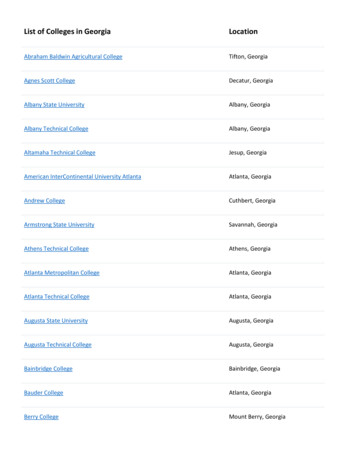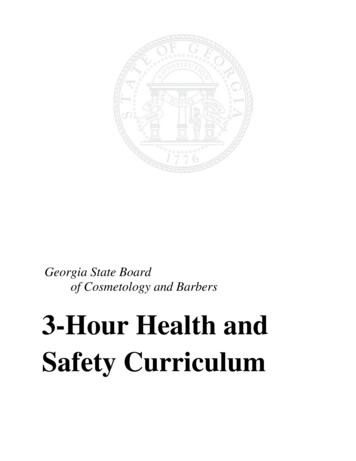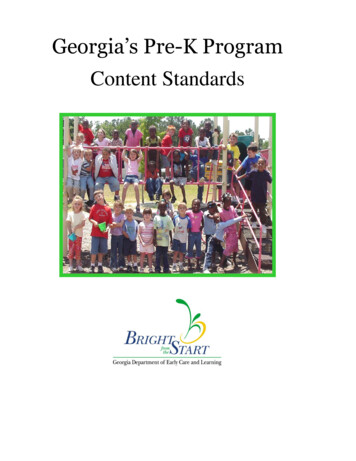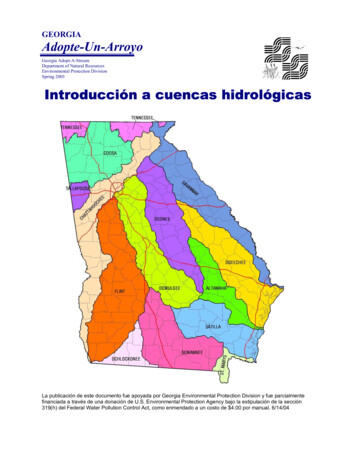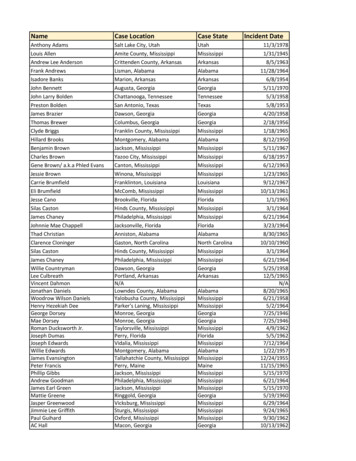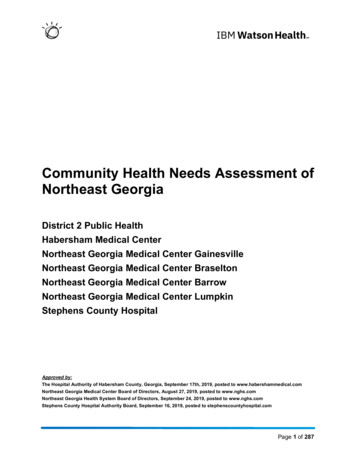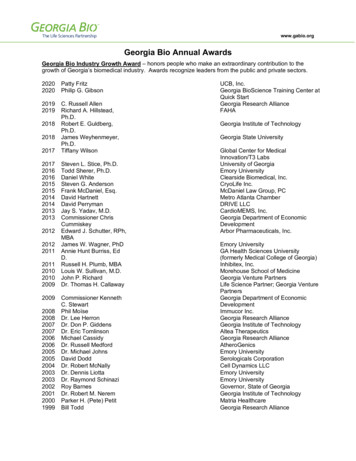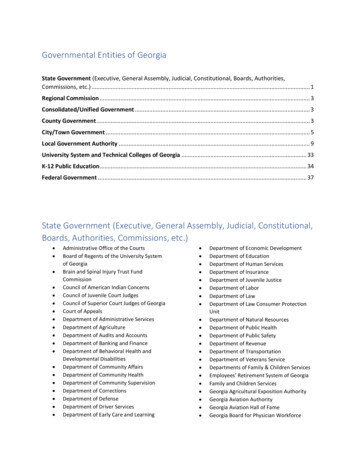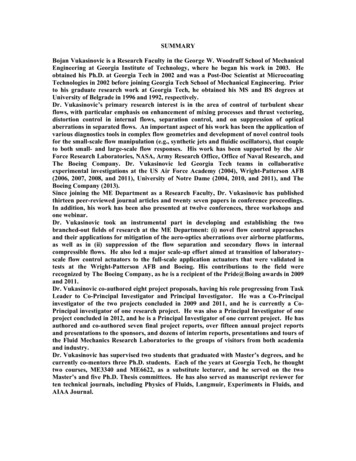
Transcription
General RulesChapter 40-7-1RULESOFGEORGIA DEPARTMENT OF AGRICULTURECHAPTER 40-7-1GENERAL RULESCONTENTSSectionCitation #RegulationPagePURPOSE &DEFINITIONS40-7-1-.0140-7-1-.02Scope of RegulationsDefinitions33MANAGEMENT& erson in ChargeResponsibility of Person in ChargePersonal CleanlinessHygienic 940-7-1-.1040-7-1-.11Condition of FoodFood from Approved SourceTransportation of FoodSpecifications for ReceivingMolluscan Shellfish Original Containers andRecord KeepingPreventing Food and Ingredient ContaminationPreventing Contamination from Ice Used as aCoolantPreventing Contamination from Equipment,Utensils, and Wiping ClothsPreventing Contamination from the PremisesPreventing Contamination by ConsumersCookingFreezingReheatingTime and Temperature ControlSpecialized Processing MethodsCurrent Good Manufacturing Practice inManufacturing, Processing, Packing, andHolding Human FoodThermally Processed Low Acid Foods Packagedin Hermetically Sealed ContainersAcidified FoodsAccurate RepresentationLabelingConsumer Advisory – Consumption of Rawor Undercooked Animal Foods2323262729Equipment and Utensils (Multiuse)Single-Service and Single-UseEquipment Durability and StrengthEquipment CleanabilityEquipment FunctionalityEquipment Numbers and , 7-1-.3240-7-1-.33130323234353538383841434343434447
General RulesChapter 40-7-1SectionCitation #RegulationPageEQUIPMENT,UTENSILS, &LINENS40-7-1-.34Utensils, Temperature Measuring Devices,and Testing DevicesLocationInstallation of EquipmentEquipment MaintenanceUtensils and Temperature MeasuringDevicesCleaning of Equipment and UtensilsCleaning FrequencyCleaningRinsing ProceduresSanitization of Equipment and UtensilsMethods of SanitizationLaunderingLaundering FrequencyLaundering MethodsProtection of Clean ItemsDrying of Equipment and UtensilsEquipment Lubricating and ReassemblingStoring of Cleaned 7-1-.62Water – Approved SourceWater QualityWater Quantity and AvailabilityDistribution, Delivery, and RetentionPlumbing System MaterialsDesign, Construction and InstallationFacility Numbers and CapacitiesOperation and Maintenance of WaterSystemsSystem Maintained in Good RepairSewage, Other Liquid Waste, and RainwaterGarbage, Refuse, and -.6540-7-1-.6640-7-1-.67Materials for Construction and RepairCleanability – Physical FacilitiesFunctionality – Physical FacilitiesNumbers and Capacities – FacilitiesFacility Operation and Maintenance7273747576POISONOUSOR TOXICMATERIALS40-7-1-.687840-7-1-.69Labeling and Identification(Poisonous or Toxic Materials)Operational Supplies and ApplicationsCOMPLIANCE 7340-7-1-.7440-7-1-.7540-7-1-.76Applicability of RegulationPlan Review and ApprovalWhen a HACCP Plan is RequiredTrade Secrets – ConfidentialityInspection FrequencyLicense to OperateInvestigation and 51WATER,PLUMBING,& 6263636363646464646570707178
General RulesChapter 40-7-140-7-1-.01 Scope of Regulations. The following regulations shall apply to all buildings, rooms, areas or places ofbusiness as defined in 40-7-1-.02 as a “FOOD SALES ESTABLISHMENT”, wherein FOOD is commerciallyPROCESSED, stored, sold or held for sale. These regulations shall be liberally construed and applied to promotetheir underlying purpose of protecting the public health.Authority Ga. L. 1956, p.195 as amended; O.C.G.A. Sec. 26-2-34 et. seq.40-7-1-.02 Definitions. The following definitions shall apply in the interpretation and enforcement of this Chapter.(1) Accredited program.(a) "Accredited program" means a FOOD protection manager certification program that has been evaluated andlisted by an accrediting agency as conforming to national standards for organizations that certify individuals.(b) "Accredited program" refers to the certification process and is a designation based upon an independentevaluation of factors such as the sponsor's mission; organizational structure; staff resources; revenue sources;policies; public information regarding program scope, eligibility requirements, re-certification, discipline andgrievance procedures; and test development and administration.(c) "Accredited program" does not refer to training functions or educational programs.(2) Additive(a) “Food Additive” has the meaning stated in the Federal Food, Drug and Cosmetic Act, paragraph 201(s) and21 CFR 170.(b) “Color Additive” has the meaning stated in the Federal Food, Drug, and Cosmetic Act, paragraph 201(t) and21 CFR 70.(3) “Adulterated” as defined in Georgia Food Code Section 26 -2 -26.(4) “Approved” means acceptable to the DEPARTMENT based on a determination of conformity with principles,practices, and generally recognized standards that protect public health.(5) “Aw” means WATER ACTIVITY.(6) “Bulk Food” means PROCESSED or unPROCESSED FOOD in aggregate containers from which quantitiesdesired by the CONSUMER are withdrawn.(7) "Beverage" means a liquid for drinking, including water.(8) "Bottled drinking water" means water that is SEALED in bottles, packages, or other containers and offered forsale for human consumption, including bottled mineral water.(9) "Casing" means a tubular container for sausage products made of either natural or artificial (synthetic) material.(10) "Certification number" means a unique combination of letters and numbers assigned by a SHELLFISHCONTROL AUTHORITY to a MOLLUSCAN SHELLFISH dealer according to the provisions of the NationalShellfish Sanitation Program.(11) “CFR” means CODE OF FEDERAL REGULATIONS.(12) CIP3
General RulesChapter 40-7-1(a) “CIP” means cleaned in place by the circulation or flowing by mechanical means through a piping system of adetergent solution, water rinse, and sanitizing solution onto or over EQUIPMENT surfaces that require cleaning suchas the method used, in part, to clean and sanitize a frozen desert machine.(b) “CIP” does not include the cleaning of EQUIPMENT such as band saws, slicers, or mixers that are subjectedto in-place manual cleaning without use of a CIP system.(13) “Code of Federal Regulations” means the compilation of the general and permanent rules published in theFederal Register by the executive departments and agencies of the federal government.(14) "Commingle" means:(a) To combine SHELLSTOCK harvested on different days or from different growing areas as identified on thetag or label, or(b) To combine SHUCKED SHELLFISH from containers with different container codes or different shuckingdates.(15) Comminuted.(a) "Comminuted" means reduced in size by methods including chopping, flaking, grinding, or mincing.(b) "Comminuted" includes FISH or MEAT products that are reduced in size and restructured or reformulatedsuch as gefilte FISH, gyros, ground beef, and sausage; and a mixture of 2 or more types of MEAT that have beenreduced in size and combined, such as sausages made from 2 or more MEATS.(16) "Confirmed disease outbreak" means a FOODBORNE DISEASE OUTBREAK in which laboratory analysisof appropriate specimens identifies a causative agent and epidemiological analysis implicates the FOOD as thesource of the illness.(17) “Consumer” means a PERSON who is a member of the public, takes possession of FOOD, is not functioningin the capacity of an operator of a FOOD SALES ESTABLISHMENT or FOOD PROCESSING PLANT, and doesnot offer the FOOD for resale.(18) “Corrosion-resistant” means those materials that maintain acceptable sanitary surface characteristics underprolonged influence of the FOOD to be contacted, the normal use of cleaning compounds and sanitizing solutions,and other conditions of the use environment.(19) “Critical control point” means a point or procedure in a specific system where loss of control may result in anunacceptable health RISK.(20) Critical Item.(a) "Critical item" means a provision of this Code that, if in noncompliance, is more likely than other violationsto contribute to FOOD contamination, illness, or environmental health HAZARD.(b) "Critical item" is an item that is denoted in this Code with an asterisk *.(21) "Critical limit" means the maximum or minimum value to which a physical, biological, or chemical parametermust be controlled at a CRITICAL CONTROL POINT to minimize the RISK that the identified FOOD safetyHAZARD may occur.(22) “Critical Violation” means any deficiency affecting the sanitation or wholesomeness of product, infestations ofrodents, insects or other vermin that might effect sanitation, which includes but is not limited to, violations affecting4
General RulesChapter 40-7-1the sanitation of FOOD products; edible product, product contact surfaces contaminated by improper cleaningprocedures, handling procedures or other insidious contamination; contaminated water supplies; or any violation thatis more likely than other violations to contribute to FOOD contamination, illness or environmental degradation.(23) “Cut leafy greens” means fresh leafy greens whose leaves have been cut, shredded, sliced, chopped, or torn.The term “leafy greens” includes iceberg lettuce, romaine lettuce, leaf lettuce, butter lettuce, baby leaf lettuce (i.e.,immature lettuce or leafy greens), escarole, endive, spring mix, spinach, cabbage, kale, arugula and chard. The term“leafy greens” does not include herbs such as cilantro or parsley.(24) “Department” means the Department of Agriculture, the State of Georgia.(25) “Department Representative” means any officer, inspector, agent or employee of the Georgia Department ofAgriculture who is authorized by the Commissioner with the duty of enforcing these regulations.(26) Drinking Water.(a) "Drinking water" means water that meets 40 CFR 141 National Primary Drinking Water Regulations.(b) "Drinking water" is traditionally known as "potable water."(c) "Drinking water" includes the term "water" except where the term used denotes that the water is not potable,such as "boiler water," "mop water," "rainwater," "wastewater," and "nondrinking" water.(27) "Dry storage" means a room or area designated for the storage of PACKAGED or containerized BULKFOOD that is not POTENTIALLY HAZARDOUS and dry goods such as SINGLE-SERVICE items.(28) Easily Cleanable.(a) "Easily cleanable" means a characteristic of a surface that:1. Allows effective removal of soil by normal cleaning methods;2. Is dependent on the material, design, construction, and installation of the surface; and3. Varies with the likelihood of the surface's role in introducing pathogenic or toxigenic agents or othercontaminants into FOOD based on the surface's APPROVED placement, purpose, and use.(b) "Easily cleanable" includes a tiered application of the criteria that qualify the surface as easily cleanable asspecified under Subparagraph (a) of this definition to different situations in which varying degrees of cleanability arerequired such as:1. The appropriateness of stainless steel for a FOOD preparation surface as opposed to the lack of need forstainless steel to be used for floors or for tables used for CONSUMER dining; or2. The need for a different degree of cleanability for a utilitarian attachment or accessory in the deli-prep area asopposed to a decorative attachment or accessory in the CONSUMER dining area.(29) "Easily movable" means:(a) Portable; mounted on casters, gliders, or rollers; or provided with a mechanical means to safely tilt a unit ofEQUIPMENT for cleaning; and(b) Having no utility connection, a utility connection that disconnects quickly, or a flexible utility connection lineof sufficient length to allow the EQUIPMENT to be moved for cleaning of the EQUIPMENT and adjacent area.5
General RulesChapter 40-7-1(30) "Egg" means the shell egg of the domesticated chicken, turkey, duck, goose, or guinea.(31) "Employee" means the LICENSE Holder, PERSON IN CHARGE, PERSON having supervisory ormanagement duties, PERSON on the payroll, family member, volunteer, PERSON performing work undercontractual agreement, or other PERSON working in a FOOD SALES ESTABLISHMENT.(32) "EPA" means the U.S. Environmental Protection Agency.(33) Equipment.(a) “Equipment” means an article that is used in the operation of a FOOD SALES ESTABLISHMENT such as afreezer, grinder, hood, ice-maker, MEAT block, mixer, oven, reach-in refrigerator, scale, sink, slicer, stove, table,TEMPERATURE MEASURING DEVICE, or WAREWASHING machine.(b) “Equipment” does not include items used for handling or storage of large quantities ofPACKAGEDFOODS that are received from a supplier in a cased or overwrapped lot, such as hand trucks, forklifts, and relatedequipment.(34) "Exclude" means to prevent a PERSON from working as a FOOD EMPLOYEE or entering a FOOD SALESESTABLISHMENT except for those areas open to the general public.(35) “Expiration Date” is synonymous with Pull Date, Best-By Date, Best Before Date, Use-By Date, and Sell-ByDate; and means the last date on which the following FOOD products can be sold at retail or wholesale:(a) PrePACKAGED sandwiches;(b) EGGS;(c) Infant formula;(d) Shucked oysters;(e) Milk; and(f) POTENTIALLY HAZARDOUS FOOD (TIME/TEMPERATURE CONTROL FOR SAFETY FOOD) that arelabeled as “keep refrigerated.”(36) Fish.(a) "Fish" means fresh or saltwater finfish, crustaceans and other forms of aquatic life (including alligator, frog,aquatic turtle, jellyfish, sea cucumber, and sea urchin and the roe of such animals) other than birds or mammals, andall mollusks, if such animal life is intended for human consumption.(b) "Fish" includes an edible human FOOD product derived in whole or in part from fish, including fish that havebeen PROCESSED in any manner(37) “Food” means a raw, cooked, or PROCESSED edible substance, ice, BEVERAGE, or ingredient used orintended for use or for sale in whole or in part for human consumption, or chewing gum.(38) "Foodborne disease outbreak" means the occurrence of two or more cases of a similar illness resulting fromthe ingestion of a common food.(39) "Food-contact surface" means:6
General RulesChapter 40-7-1(a) A surface of EQUIPMENT or a UTENSIL with which FOOD normally comes into contact; or(b) A surface of EQUIPMENT or a UTENSIL from which FOOD may drain, drip, or splash:1. Into a FOOD, or2. Onto a surface normally in contact with FOOD.(40) "Food employee" means an individual working with unPACKAGED FOOD, FOOD EQUIPMENT orUTENSILS, or FOOD-CONTACT SURFACES.(41) Food Sales Establishment.(a) “Food Sales Establishment” means retail and wholesale grocery stores; retail seafood stores and places ofbusiness; FOOD PROCESSING PLANTS, seafood PROCESSING plants, except those FOOD PROCESSINGPLANTS which are currently required to obtain a LICENSE from the Commissioner under any other provision ofLAW; bakeries; confectioneries; fruit, nut, and vegetable stores or roadside stands; wholesale sandwich and saladmanufacturers, including VENDING MACHINES and operations connected therewith; and places of business andsimilar establishments, mobile or permanent, engaged in the sale of FOOD primarily for consumption offPREMISES. Within a Food Sales Establishment, there may be a FOOD service component, not separately operated,which may serve customers on site. This FOOD service component shall be considered as part of the Food SalesEstablishment. The FOOD sales component of any Food Service Establishment defined in Code Section 26-2-370shall not be included in this definition. Such “Food Sales Establishments” shall; except as in paragraph (b) of thispart; comply with all requirements as set forth in these regulations.(b) “Food Sales Establishments” shall include cottage food operations. See DEPARTMENT rules Chapter 40-719 for regulations and requirements specific to cottage food operations.(c) “Food Sales Establishments” which do not receive, store, prepare, PROCESS, ship, display for sale or sellany open FOOD, including but not limited to coffee, drinks, either dispensed or poured into an open container orany non-PACKAGED FOOD products including ice or POTENTIALLY HAZARDOUS FOOD(TIME/TEMPERATURE CONTROL FOR SAFETY FOOD) as defined in part 40-7-1-.02, or are involved in themanufacture and bagging of ice; may be exempt from the requirement for a three/two compartment sink with hot andcold running water under pressure, hand wash sink with hot and cold running water under pressure and a rest room ,within the confines of the establishment; if there is convenient access to acceptable rest room facilities; and in theopinion of the DEPARTMENT, no public health RISK will result from such action; however; all other provisions ofthese regulations shall be complied with as applicable.(d) This term shall not include “Food Service Establishments” as defined in Section 26-2-370.(e) This term also shall not include establishments engaged in the boiling, bottling, and sale of sugar cane syrup orsorghum syrup within this state, provided that such bottles contain a label listing the producer's name and streetaddress, all added ingredients, and the net weight or volume of the product.(f) This term also shall not include establishments engaged in the sale of FOOD primarily for consumption off thePREMISES if such sale is an authorized part of, and occurs upon the site of a fair or festival which:1. Is sponsored by a political subdivision of this state or by an organization exempt from taxes under paragraph(1) of subsection (a) of Code Section 48-7-25 or under Section 501(d) or paragraphs (1) through (8) or paragraph(10) of Section 501(c) of the Internal Revenue Code, as that is defined in Code Section 48-1-2;2. Lasts 120 hours or less; and3. When sponsored by such an organization, is authorized to be conducted pursuant to a permit issued by themunicipality or county in which it is conducted.7
General RulesChapter 40-7-1(42) Food Processing Plant.(a) "Food processing plant" means a commercial operation that manufactures, packages, labels, or stores FOODfor human consumption and does not provide FOOD directly to a CONSUMER.(b) "Food processing plant" does not include a FOOD SALES ESTABLISHMENT as defined underSubparagraph 40-7-1-.02(38).(43) Game Animal.(a) "Game animal" means an animal, the products of which are FOOD, that is not classified as cattle, sheep,swine, goat, horse, mule, or other equine in 9 CFR Subchapter A - Mandatory Meat Inspection, Part 301, as Poultryin 9 CFR Subchapter C - Mandatory Poultry Products Inspection, Part 381, or as FISH as defined underSubparagraph 40-7-1-.02(33).(b) "Game animal" includes mammals such as reindeer, elk, deer, antelope, water buffalo, bison, rabbit, squirrel,opossum, raccoon, nutria, or muskrat, and nonaquatic reptiles such as land snakes.(c) "Game animal" does not include ratites such as ostrich, emu, and rhea.(44) "General use pesticide" means a pesticide that is not classified by EPA for restricted use as specified in 40CFR 152.175.(45) "Grade A standards" means the requirements of the United States Public Health Service/FDA "Grade APasteurized Milk Ordinance" and "Grade A Condensed and Dry Milk Ordinance" with which certain fluid and drymilk and milk products comply.(46) “GMP” refers to Good Manufacturing Practice as referenced in 21 CFR 110.(47) “HACCP Plan” means a written document that delineates the formal procedures for following the HazardAnalysis CRITICAL CONTROL POINT principals developed by The National Advisory Committee onMicrobiological Criteria for foods.(48) “Hazard” means a biological, chemical, or physical property that may cause an unacceptable CONSUMERhealth RISK.(49) “Hermetically sealed container” means a container which is designed and intended to secure against entry ofmicroorganisms and, in the case of low acid canned FOODS, to maintain the commercial sterility of its contents afterPROCESSING.(50) “Imminent health hazard” means a significant threat or danger to health that is considered to exist when thereis evidence to show that a product, practice, circumstance, or event creates a situation that requires immediatecorrection or cessation of operation to prevent injury based on:(a) The number of potential injuries; and(b) The nature, severity, and duration of the anticipated injury.(51) “Injected” means manipulating a MEAT so that infectious or toxigenic microorganisms may be introducedfrom its surface to its interior through tenderizing with deep penetration or injecting the MEAT such as with juiceswhich may be referred to as “injecting,” “pinning,” or “stitch pumping”(52) "Juice" means, when used in the context of FOOD safety, the aqueous liquid expressed or extracted from oneor more fruits or vegetables, purées of the edible portions of one or more fruits or vegetables, or any concentrates of8
General RulesChapter 40-7-1such liquid or purée. Juice includes juice as a whole BEVERAGE, an ingredient of a BEVERAGE and a purée as aningredient of a BEVERAGE.(53) “Law” means applicable local, state, and federal statutes, regulations, and ordinances.(54) "Linens" means fabric items such as cloth hampers, cloth napkins, table cloths, wiping cloths, and workgarments including cloth gloves.(55) “License” means the document issued by the DEPARTMENT, which authorizes a PERSON to operate aFOOD SALES ESTABLISHMENT. The DEPARTMENT does not issue Temporary License.(56) “Meat” means the flesh of animals used as FOOD including the dressed flesh of cattle, swine, sheep, or goatsand other edible animals, except FISH, POULTRY, and wild game that is offered for human consumption.(57) “mg/L” means milligrams per liter, which is the metric equivalent of parts per million (ppm).(58) “Molluscan shellfish” means any edible species of fresh oysters, clams, mussels, and scallops or edibleportions thereof, except when the scallop product consists only of the shucked adductor muscle.(59) Packaged.(a) “Packaged” means bottled, canned, cartoned, bagged or securely wrapped, whether packaged in a FOODSALES ESTABLISHMENT or a FOOD PROCESSING PLANT.(b) “Packaged” does not include a wrapper, carry-out box, or other nondurable container used to containerizeFOOD with the purpose of facilitating FOOD protection during service and receipt of the FOOD by theCONSUMER.(60) “Person” means an association, a corporation, individual, partnership, other legal entity, government, orgovernmental subdivision or agency,(61) “Person in charge” means the individual present at a FOOD SALES ESTABLISHMENT who is responsiblefor the operation at the time of inspection, as defined in part 40-7-1-.03 of these regulations.(62) Personal Care Items.(a) "Personal care items" means items or substances that may be poisonous, toxic, or a source of contaminationand are used to maintain or enhance a PERSON'S health, hygiene, or appearance.(b) "Personal care items" include items such as medicines; first aid supplies; and other items such as cosmetics,and toiletries such as toothpaste and mouthwash.(63) “pH” means the symbol for the negative logarithm of the hydrogen ion concentration, which is a measure of thedegree of acidity or alkalinity of a solution.(64) “Physical facilities” means the structure and interior surfaces of a FOOD SALES ESTABLISHMENTincluding accessories such as soap and towel dispensers and attachments such as light fixtures and heating or airconditioning system vents.(65) “Plumbing fixture” means a receptacle or device that:(a) Is permanently or temporarily connected to the water distribution system of the PREMISES and demands asupply of water from the system; or9
General RulesChapter 40-7-1(b) Discharges used water, waste materials, or SEWAGE directly or indirectly to the drainage system of thePREMISES.(66) “Plumbing system” means the water supply and distribution pipes; PLUMBING FIXTURES and traps; soil,waste, and vent pipes; sanitary and storm sewers and building drains, including their respective connections, devices,and appurtenances within the PREMISES; and water-treating EQUIPMENT.(67) “Poisonous or toxic materials” means substances that are not intended for ingestion and are included in 4categories.(a) Cleaners and sanitizers, which include cleaning and sanitizing agents and agents such as caustics, acids, dryingagents, polishes, and other chemicals.(b) Pesticides which include substances such as insecticides and rodenticides.(c) Substances that are not necessary for the operation and maintenance of the establishment such as nonFOODgrade lubricants and PERSONAL CARE ITEMS that may be deleterious to health; and(d) Substances that are not necessary for the operation and maintenance of the establishment and are on thePREMISES for retail sale, such as petroleum products and paints.(68) “Potentially Hazardous Food (Time/Temperature Control for Safety Food)" means a FOOD that requirestime/temperature control for safety (TCS) to limit pathogenic microorganism growth or toxin formation.(a) "Potentially hazardous food (time/temperature control for safety food)" includes:1. An animal FOOD that is raw or heat-treated; a plant FOOD that is heat treated or consists of raw seed sprouts,cut melons, CUT LEAFY GREENS, cut tomatoes or mixtures of cut tomatoes that are not modified in a way sothat they are unable to support pathogenic microorganism growth or toxin formation, or garlic-in-oil mixtures thatare not modified in a way so that they are unable to support pathogenic microorganism growth or toxin formation;and2. Except as specified in Subparagraph (b)4 of this definition, a FOOD that because of the interaction of its Awand pH values is designated as Product Assessment Required (PA) in Table A or B of this definition:10
General RulesChapter 40-7-1(b) "Potentially hazardous food (time/temperature control for safety food)" does not include:1. An air-cooled hard-boiled EGG with shell intact, or an EGG with shell intact that is not hard-boiled, but hasbeen pasteurized to destroy all viable salmonellae;2. A FOOD in an unopened HERMETICALLY SEALED CONTAINER that is commercially PROCESSED toachieve and maintain commercial sterility under conditions of non-refrigerated storage and distribution;3. A FOOD that because of its pH or Aw value, or interaction of Aw and pH values, is designated as a nonPHF/non-TCS FOOD in Table A or B of this definition;4. A FOOD that is designated as Product Assessment Required (PA) in Table A or B of this definition and hasundergone a Product Assessment showing that the growth or toxin formation of pathogenic microorganisms thatare reasonably likely to occur in that FOOD is precluded due to:(i) Intrinsic factors including added or natural characteristics of the FOOD such as preservatives,antimicrobials, humectants, acidulants, or nutrients,(ii) Extrinsic factors including environmental or operational factors that affect the FOOD such as packaging,modified atmosphere such as REDUCED OXYGEN PACKAGING, shelf life and use, or temperature range ofstorage and use, or(iii) A combination of intrinsic and extrinsic factors; or5. A FOOD that does not support the growth or toxin formation of pathogenic microorganisms in accordancewith one of the Subparagraphs (b)1 - (b)4 of this definition even though the FOOD may contain a pathogenicmicroorganism or chemical or physical contaminant at a level sufficient to cause illness or injury.(69) Poultry.11
General RulesChapter 40-7-1(a) "Poultry" means:1. Any domesticated bird (chickens, turkeys, ducks, geese, or guineas), whether live or dead, as defined in 9CFR 381 Poultry Products Inspection Regulations; and2. Any migratory waterfowl, game bird, such as pheasant, partridge, quail, grouse, or guinea, or pigeon or squab,whether live or dead, as defined in 9 CFR 362 Voluntary Poultry Inspection Program.(b) "Poultry" does not include ratites.(70) “Premises” means:(a) The physical facility, its contents, and the contiguous land or property under the control of the permit holder or;(b) The physical facility, its contents, and the contiguous land or property and its facilities and contents that areunder the control of the permit holder that may impact FOOD SALES ESTABLISHMENT personnel, facilities, oroperations, if a FOOD SALES ESTABLISHMENT is only one component of a larger organization .(71) “Primal cut” means a basic major cut into which carcasses and sides of MEAT are separated, such as a beefround, pork loin, lamb flank or veal breast.(72) “Private water system” means a system for the provision of piped water for human consumption that is not aPUBLIC WATER SYSTEM.(73) “Processing” or “Process” means any or all of the physical and/or chemical alterations applied to a FOOD; asit is taken from its original state; or any FOOD which has been partially or fully PROCESSED previously; and eitherprepared further by cooking or made into another form before being marketed.(74) “Product Code” is a method with which a CONSUMER size product package is marked, from which accuratePROCESS information such as, but not limited to, date of production, lot designation, PROCESS line identification,or any other information which would provide product traceability, should there be a recall or other need for suchinformation.(75) “Public water system” has the meaning stated in 40 CFR Part 141 National Drinking Water Regulations.(76) Ready-to-Eat Food.(a) "Ready-to-eat food" means FOOD that:(i) Is in a form that is edible without additional preparation to achieve FOOD safety, as specified under ¶ 40-71-.17(1) (a) or 40-7-1-.17(2) or 40-7-1-.18; or(ii) Is a
GEORGIA DEPARTMENT OF AGRICULTURE CHAPTER 40-7-1 GENERAL RULES CONTENTS Section Citation # Regulation Page PURPOSE & 40-7-1-.01 Scope of Regulations 3 DEFINITIONS 40-7-1-.02 Definitions 3 MANAGEMENT 40-7-1-.03 Person in Charge 16 & PERSONNEL 40-7-1-.04 Responsibility of Person in Charge 17 .
